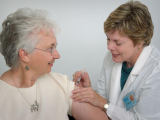Oct 9, 2007 (CIDRAP News) – In quick succession, the view that influenza shots yield life-saving benefits for elderly people has come under serious attack and received fresh support in recent weeks.
One group of experts, writing in the October issue of Lancet Infectious Diseases, argued that the mortality benefits of flu shots for the elderly have been greatly exaggerated because of a subtle bias and other methodologic problems in many of the relevant studies.
"The remaining evidence base is currently insufficient to indicate the magnitude of the mortality benefit, if any, that elderly people derive from the vaccination programme," says the analysis by Lone Simonsen, PhD, of George Washington University in Washington, DC, and colleagues.
But in the Oct 4 New England Journal of Medicine (NEJM), another team of experts presented a study showing that in the course of up to 10 flu seasons, flu shots reduced the risk of hospitalization for pneumonia and flu by 27% and shrank the risk of death by 48% for elderly members of three health maintenance organizations (HMOs). The study addresses several of the methodologic problems raised by the Lancet authors.
"Vaccine delivery to this high-priority group should be improved," states the report by Kristin Nichol, MD, of the Minneapolis Veterans Affairs Medical Center and University of Minnesota, and four coauthors.
The controversy has major policy implications, since the Centers for Disease Control and Prevention (CDC) and other medical groups heavily promote flu shots for elderly people, given their risk for serious complications if they contract the flu. This policy is reinforced by Medicare coverage of flu shots for this age-group.
A sharp critique of the evidence
The Lancet Infectious Diseases authors offer several reasons for questioning the notion that flu immunization saves lives in the elderly population:
- Vaccination coverage among the elderly has increased from 15% to 65% since 1980, but instead of declining, overall mortality due to pneumonia and influenza in elderly people has increased in that period.
- Few randomized, placebo-controlled trials have examined flu vaccine effectiveness in elderly people. The largest and best study, done in the Netherlands, showed a 50% reduction in confirmed flu cases among all the volunteers, but the reduction for those older than 70 was only 23%. There was no significant reduction in influenza-like illness.
- A number of investigators have reported finding evidence of flu vaccination benefits in the elderly by analyzing the records of large healthcare organizations. But these studies typically are flawed in that investigators looked for an effect on all-cause mortality, a nonspecific outcome, rather than on lab-confirmed flu. Further, many such studies may be marred by a subtle selection bias, wherein relatively healthy older people were more likely to be vaccinated than frail seniors were, thereby making vaccination look more beneficial than it really was. A further problem is that cohort studies typically have defined the flu season arbitrarily as December through March, rather than on the basis of flu surveillance.
Simonsen and colleagues also write that since 1968, flu has accounted for an average of about 5% of all winter deaths in older people. Yet the results of cohort studies have prompted claims that flu vaccination reduces the risk of winter death from any cause by about 50% for community-dwelling people older than 65. "That influenza vaccination can prevent ten times as many deaths as the disease itself causes is not plausible," say Simonsen et al.
They argue that in view of the "slim" evidence that flu immunization prolongs elderly people's lives, it may be time to consider doing more randomized, placebo-controlled trials—even though using a placebo would be "ethically unappealing." In addition, they suggest, other options for protecting the elderly should be pursued, such as developing vaccines that are more immunogenic, using larger vaccine doses, and employing antiviral drugs more aggressively.
Meanwhile, the researchers say elderly people should continue to be vaccinated, because "even a partly effective vaccine would be better than no vaccine at all."
Critiquing the critique
The review by Simonsen and colleagues drew praise in an editorial in The Lancet, written by two other vaccine experts who have reviewed the case for flu immunization in the elderly. Tom Jefferson and Carlo Di Pietrantonj of the Cochrane Vaccine Fields in Alessandria, Italy, write that Smonsen et al "prove that statistical methods for adjustment for residual bias used in the observational studies of influenza vaccines did not work, largely because of the difficulty of adjusting for frailty with data available in electronic records."
Jefferson and Di Pietrantonj endorse the idea of doing new randomized, placebo-controlled trials of flu vaccination in older people, arguing that such studies are "the only ethical and scientific way" to settle conclusively whether the vaccines are protective. The trials must cover more than one flu season and be large enough to detect rare outcomes, such as deaths due to flu, the pair assert.
In an interview, a flu expert with the CDC asserted that the evidence of effectiveness remains strong enough to justify the US policy of promoting flu shots for the elderly. David K. Shay, MD, MPH, a medical officer in the CDC's influenza division, agreed that better vaccines are needed, but he rejected the idea of doing placebo-controlled trials in the elderly as unethical.
Shay said the randomized, controlled trial from the Netherlands that showed a 50% reduction in confirmed flu cases among the elderly provided "gold standard evidence" for a protective effect. The risk was reduced 57% in 60- to 69-year-olds versus 23% in those 70 and older, but because of wide confidence intervals, the difference between the two groups was not significant, he said.
The Dutch findings and the high risk of flu-related hospitalization and death in the elderly provide the major underpinnings of the US policy of promoting flu vaccination in the elderly, Shay said, adding, "We're left with the fact that this study [by Simonsen et al] isn't going to change policy in the US for the use of these vaccines."
He said it is very difficult to demonstrate a reduction in mortality as a result of vaccination: "No vaccine trial ever done in the developed world has been [statistically] powered to look at a mortality benefit. So we're going to have to rely on observational data."
As for the suggestion that unmeasured confounding variables have inflated the effectiveness of flu vaccines in observational studies, Shay said, "We also think that's possible. The CDC is interested in working with HMOs to get a better handle on how to do vaccine effectiveness studies and mortality outcome studies."
But given the existing evidence that flu shots do help protect seniors, he rejected the suggestion of doing placebo-controlled trials. "If you can't honestly answer, 'I have no idea' to the question whether the vaccine is effective, then you have no basis for doing a placebo-controlled trial," he said.
On the other hand, Shay commented, "Everybody would agree that we need a vaccine with greater effectiveness and greater immunogenicity in the elderly. Manufacturers are working on adjuvanted vaccines that hopefully will be more effective."
HMO study addresses methodologic issues
In the NEJM study, Nichol and associates sought specifically to address the kinds of methodologic problems cited by Simonsen et al. They retrospectively gathered data on flu vaccination, hospitalization for pneumonia and flu, and death from any cause among community-dwelling elderly members of three HMOs. The study covered the flu seasons from 1990-91 through 1999-2000 for one HMO and those from 1996-97 through 1999-2000 for the other two. The HMOs were in Minnesota and Wisconsin, Washington state, and the New York City area.
The study included 713,872 person-seasons of observation. Vaccinated subjects were slightly older and had slightly higher rates of most of the underlying medical conditions that were recorded. There were 4,599 hospitalizations for pneumonia or flu and 8,796 deaths.
The per-season hospitalization rates for unvaccinated and vaccinated people were 0.7% and 0.6%, and the corresponding death rates were 1.6% and 1.0%. The figures translated into a 27% reduction in hospitalization rate for pneumonia and flu among the vaccinated (adjusted odds ratio, 0.73; 95% confidence interval [CI], 0.68 to 0.77) and a 48% reduction in mortality (adjusted odds ratio, 0.52; 95% CI, 0.50 to 0.55).
The vaccine was somewhat less effective in preventing death—a 37% compared with 48% reduction—in the two seasons when the vaccine was a poor match for the circulating viral strains. For the seasons in which there was a good match, the vaccine yielded a 52% reduction in mortality risk.
In an effort to detect any "healthy-vaccinee bias" (better underlying health among the vaccinated than the unvaccinated), the authors compared the risk of hospitalization among vaccinated and unvaccinated subjects during the summers (noninfluenza seasons) of 1999 and 2000. They found that the risks were similar for the two groups.
The researchers went a step further by hypothesizing that an unmeasured confounding variable was influencing their findings and then estimating what that influence would be under various assumptions. They picked functional status as the unmeasured variable most likely to affect their subjects' risk of hospitalization or death.
On the basis of studies of functional status, the authors estimated that subjects with poor functional status would be half as likely to get a flu shot and two to three times as likely to be hospitalized or die, compared with those with better functional status. When they plugged these estimates into their data, along with estimates of the prevalence of the confounding variable, they found that the effectiveness of vaccination was reduced but still significant.
For example, assuming that the confounder was present in 60% of subjects and that it doubled the risk of hospitalization or death, vaccination still reduced the risk of hospitalization by 14% and the risk of death by 39%. In the most extreme scenario—the confounder was prevalent in 60% and tripled the risk of hospitalization or death—vaccination still lowered the risk of hospitalization 7% and the risk of death 33%.
The researchers write that their study "showed multiple benefits across multiple subgroups, a result suggesting that vaccination benefits probably extend to a broad spectrum of elderly persons." However, they acknowledge that elderly HMO members may differ from elderly nonmembers, and the study did not include the frailest elderly, such as those living in nursing homes, who are likely to have weaker immune responses.
A confidence booster
In an accompanying NEJM editorial, John D. Treanor, MD, writes that the study by Nichol et al addresses many of the concerns raised about other observational studies "and increases our confidence in the benefits of influenza vaccination in older adults."
Because the evidence of vaccine effectiveness held up well through 10 seasons, the findings "convincingly dispel concerns that the previous studies were artifacts of a specific influenza season or a specific population," states Treanor, who is a vaccine researcher; professor of medicine, microbiology, and immunology at the University of Rochester; and member of the CDC's Advisory Committee on Immunization Practices.
He also comments favorably on the authors' efforts to address the concerns about unmeasured confounding variables, including the examination of summer hospitalization rates and the estimate of the effect of a hypothetical difference in functional status.
"Overall, this study provides additional support for the current strategy to vaccinate elderly adults," Treanor asserts. The methodologic issues are important, and the precise magnitude of the benefits of vaccination is not yet clear, but it is clear that vaccination is beneficial and should be used widely, he adds.
However, he agrees with Shay that the development of more immunogenic and effective vaccines for the elderly is an important goal.
Shay said the CDC is contemplating a special initiative to help resolve the controversy over the value of flu immunization for seniors. "Sometime in 2008 the CDC hopes to get together a panel of consultants to bring about ways to move forward and find ways to resolve this controversy," he said. By assembling experts from the different camps, the agency hopes to come up with recommendations to guide the next series of studies, he said.
Simonsen L, Taylor RJ, Viboud C, et al. Mortality benefits of influenza vaccination in elderly people: an ongoing controversy. Lancet Infect Dis 2007 Oct;7:658-66 [Abstract]
Jefferson T, Di Pietrantonj C. Inactivated influenza vaccines in the elderly—are you sure? (Editorial) Lancet 2007 Oct 6;370(9594):1199-1200
Nichol KL, Nordin JD, Nelson DB, et al. Effectiveness of influenza vaccine in the community-dwelling elderly. N Engl J Med 2007 Oct 4;357(14):1373-81 [Full text]
Treanor JD. Influenza—the goal of control. (Editorial) N Engl J Med 2007 Oct 4;357(14):1439-41 [Full text]


















